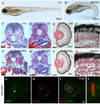IFT46 plays an essential role in cilia development
- PMID: 25722189
- PMCID: PMC4385464
- DOI: 10.1016/j.ydbio.2015.02.009
IFT46 plays an essential role in cilia development
Abstract
Cilia are microtubule-based structures that project into the extracellular space. Ciliary defects are associated with several human diseases, including polycystic kidney disease, primary ciliary dyskinesia, left-right axis patterning, hydrocephalus and retinal degeneration. However, the genetic and cellular biological control of ciliogenesis remains poorly understood. The IFT46 is one of the highly conserved intraflagellar transport complex B proteins. In zebrafish, ift46 is expressed in various ciliated tissues such as Kupffer׳s vesicle, pronephric ducts, ears and spinal cord. We show that ift46 is localized to the basal body. Knockdown of ift46 gene results in multiple phenotypes associated with various ciliopathies including kidney cysts, pericardial edema and ventral axis curvature. In ift46 morphants, cilia in kidney and spinal canal are shortened and abnormal. Similar ciliary defects are observed in otic vesicles, lateral line hair cells, olfactory pits, but not in Kupffer׳s vesicle. To explore the functions of Ift46 during mouse development, we have generated Ift46 knock-out mice. The Ift46 mutants have developmental defects in brain, neural tube and heart. In particular Ift46(-/-) homozygotes displays randomization of the embryo heart looping, which is a hallmark of defective left-right (L/R) axis patterning. Taken together, our results demonstrated that IFT46 has an essential role in vertebrate ciliary development.
Keywords: Cilia; Ciliopathy; IFT; IFT46; Intraflagellar transport; KO mouse; L/R defect; Zebrafish.
Copyright © 2015 Elsevier Inc. All rights reserved.
Figures






References
-
- Badano J, Mitsuma N, Beales P, Katsanis N. The ciliopathies: an emerging class of human genetic disorders. Annu. Rev. Genomics Hum. Genet. 2006;7:125–148. - PubMed
-
- Cho S, Kim S, Kim J, Kim J-S. Targeted genome engineering in human cells with the Cas9 RNA-guided endonuclease. Nat. Biotechnol. 2013;31:230–232. - PubMed
-
- Cole D, Snell W. SnapShot: Intraflagellar transport. Cell. 2009;137:784–784.e1. - PubMed
Publication types
MeSH terms
Substances
Grants and funding
LinkOut - more resources
Full Text Sources
Other Literature Sources
Molecular Biology Databases
Research Materials
Miscellaneous

